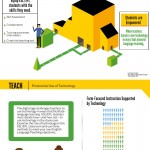As we continue to see rapid advancements in technology, the ways we communicate are evolving at an unprecedented rate. One emerging possibility is the development of communication methods that move beyond traditional language, utilizing images to convey information more efficiently. For TESOL (Teaching English to Speakers of Other Languages) educators, this shift could have profound implications on language teaching, learning, and the broader concept of literacy in the future.
The Rise of Visual Communication
Traditionally, language has been the primary means through which humans convey thoughts, emotions, and knowledge. Spoken and written words have allowed us to express complex ideas and share experiences. However, in today’s fast-paced digital world, visual communication is becoming more dominant, with images, videos, and emojis increasingly taking the place of words in social media, advertising, and everyday interactions.
The evolution toward visual communication can be seen in the way people now prefer to consume information: infographics, memes, and video content are often favored over long blocks of text. This shift towards visual learning aligns with the idea that a picture can convey complex ideas more quickly and effectively than words alone. For example, an infographic can summarize a report’s key findings in seconds, while reading the entire report would take much longer.
The Potential of Brain-Computer Interfaces
One of the most exciting developments in the field of communication is the exploration of brain-computer interfaces (BCIs). BCIs allow direct communication between the brain and an external device, enabling individuals to interact with technology using their thoughts. Currently, BCIs are being used for assistive technologies that help individuals with disabilities control devices or communicate. In the future, however, BCIs could revolutionize the way we transfer information and connect with others.
Imagine a world where instead of using language, people could transfer detailed images, concepts, or even sensory experiences directly from one mind to another. This development could vastly increase the speed and accuracy of communication. For instance, rather than verbally explaining a complex idea, a person could share a mental image that captures the entirety of their thought. Such a form of communication would enable larger chunks of information to be transmitted more quickly than through traditional language, allowing for more efficient exchanges of knowledge.
What This Means for TESOL Educators
As the world moves toward more visually-oriented communication, the role of language teachers may need to adapt. Here are some key areas where TESOL educators can prepare for the future:
- Integrating Visual Literacy in Language Instruction: With the increasing importance of visual communication, teaching visual literacy becomes essential. Visual literacy involves the ability to interpret, use, and create visual content. For English language learners, this could mean not only understanding how to use images effectively but also learning how to navigate a world where text and images are intertwined.
- Adapting Language Learning Techniques: If communication begins to shift from words to images, TESOL educators will need to explore innovative ways to teach language that incorporate more visual elements. For example, lessons could include interpreting infographics, discussing visual art, or analyzing social media content that blends text with images. This approach would allow students to engage with language in a way that aligns with future communication trends.
- Preparing for Multimodal Communication: The future of communication is likely to be multimodal, combining text, images, video, and even brain-generated content. Language teachers can help students become adept at switching between different modes of communication, understanding not just the language but also the context in which it is used. This would involve teaching students how to effectively combine spoken or written language with visual aids to enhance meaning.
- Emphasizing Cultural Context in Visual Communication: Just as language carries cultural nuances, images and symbols can have different meanings across cultures. TESOL educators will need to teach students how to interpret visuals within cultural contexts, helping them avoid misunderstandings when communicating with people from different backgrounds.
Implications of Brain-Computer Interface Technology
The potential use of BCIs to transfer brain images and concepts between humans or from human to machine opens up new possibilities in education. If BCIs become widely available, they could fundamentally alter the way language learning is approached:
- Enhanced Language Learning with BCIs: With BCIs, it may be possible for students to receive direct visual input related to language learning. For example, instead of reading a text about a historical event, students could receive a mental simulation that visually represents the event, providing a deeper understanding and a more immersive experience. This could significantly improve language retention and comprehension, as the brain processes images faster than words.
- Personalized Learning Experiences: BCIs could enable personalized language learning experiences based on real-time brain activity. For instance, if a learner struggles with understanding a particular grammatical concept, a BCI could detect this and provide targeted visual support or suggest alternative explanations to aid comprehension.
- New Methods for Assessing Language Proficiency: Traditional assessments that rely on written and spoken responses might be complemented or even replaced by assessments that measure a student’s ability to comprehend and interpret visual information. BCIs could analyze how students process visual stimuli in real-time, providing insights into their understanding and learning progress.
Challenges and Ethical Considerations
While the prospect of using visual communication and BCIs in education is exciting, it does come with challenges and ethical considerations. These include:
- Privacy Concerns: BCIs would have access to brain activity, potentially raising concerns about data privacy. Ensuring that students’ mental data is protected will be crucial if this technology is to be implemented in educational settings.
- Accessibility and Equity: The cost of BCI technology may initially limit its availability to well-funded schools or institutions. TESOL educators must consider how to make such technologies accessible to all students, regardless of socioeconomic status.
- Maintaining Traditional Language Skills: While visual communication may gain prominence, it is unlikely that traditional language skills will become obsolete. Educators will need to find a balance between teaching visual literacy and maintaining a focus on traditional language skills such as reading, writing, speaking, and listening.
Conclusion
The future of communication holds exciting possibilities, with a shift towards more visual methods of information transfer and the potential integration of brain-computer interfaces. For TESOL teachers, these developments present opportunities to expand the scope of language instruction, integrating visual literacy and multimodal communication into the curriculum. As technology continues to evolve, the role of educators will be crucial in helping students navigate the changing landscape of communication while still preserving the core skills needed for effective language use.
In preparing for these changes, TESOL educators can lead the way in embracing new teaching methodologies that combine traditional language skills with cutting-edge technology, ensuring that students are well-equipped for the future.
Learn More – TESOL2 – Images as a Universal Form of Communication



